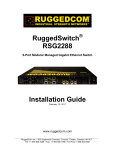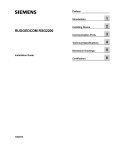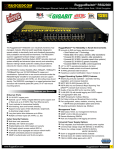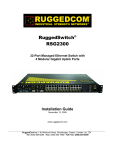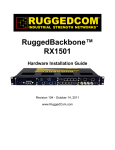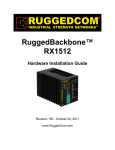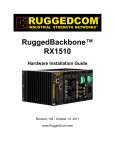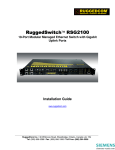Download Siemens RUGGEDCOM RSG2200 Installation guide
Transcript
RuggedSwitch RSG2200 ® 9-Port Modular Managed Gigabit Ethernet Switch Installation Guide June 2, 2011 www.ruggedcom.com RuggedCom Inc. I 300 Applewood Crescent, Concord, Ontario, Canada L4K 5C7 Tel: +1 905 856 5288 I Fax: +1 905 856 1995 I Toll Free: 1 888 264 0006 Copyright COPYRIGHT © 2010 RuggedCom Inc. ALL RIGHTS RESERVED Dissemination or reproduction of this document, or evaluation and communication of its contents, is not authorized except where expressly permitted. Violations are liable for damages. All rights reserved, particularly for the purposes of patent application or trademark registration. This document contains proprietary information, which is protected by copyright. All rights are reserved. No part of this document may be photocopied, reproduced or translated to another language without the prior written consent of RuggedCom Inc. Disclaimer of liability We have checked the contents of this manual against the hardware and software described. However, deviations from the description cannot be completely ruled out. RuggedCom shall not be liable for any errors or omissions contained herein or for consequential damages in connection with the furnishing, performance, or use of this material. The information given in this document is reviewed regularly and any necessary corrections will be included in subsequent editions. We appreciate any suggested improvements. We reserve the right to make technical improvements without notice. Registered Trademarks RuggedRated™ and eRSTP™ are trademarks of RuggedCom Inc. ROS®, RuggedRouter® and RuggedSwitch® are registered trademarks of RuggedCom Inc. Other designations in this manual might be trademarks whose use by third parties for their own purposes would infringe the rights of the owner. Contacting RuggedCom Corporate Headquarters US Headquarters Europe Headquarters RuggedCom Inc. 300 Applewood Crescent Concord, Ontario Canada, L4K 5C7 RuggedCom 1930 Harrison St., Suite 209 Hollywood, Florida USA, 33020 RuggedCom Unit 41, Aztec Centre, Aztec West, Almondsbury, Bristol United Kingdom BS32 4TD Tel: +1 905 856 5288 Fax: +1 905 856 1995 Toll-free: 1 888 264 0006 Tel: +1 954 922 7938 ext. 103 Tel: Fax: +1 954 922 7984 Fax: Toll-free: 1 888 264 0006 Email: [email protected] +44 1454 203 404 +44 1454 203 403 Technical Support Toll Free (North America): 1 866 922 7975 International: +1 905 856 5288 Email: [email protected] Web: www.RuggedCom.com RuggedCom® 2 RuggedSwitch® RSG2200 Installation Guide rev115 Federal Communications Commission Radio Frequency Interference Statement This equipment has been tested and found to comply with the limits for a Class A digital device pursuant to Part 15 of the FCC Rules. These limits are designed to provide reasonable protection against harmful interference when the equipment is operated in a commercial environment. This equipment generates, uses and can radiate radio frequency energy and, if not installed and used in accordance with the instruction manual, may cause harmful interference to radio communications. Operation of this equipment in a residential area is likely to cause harmful interference in which case the user will be required to correct the interference on his own expense. CAUTION This product contains a laser system and is classified as a “CLASS 1 LASER PRODUCT” CAUTION Use of controls or adjustments or performance of procedures other than those specified herein may result in hazardous radiation exposure. This product contains no user-serviceable parts. Attempted service by unauthorized personnel shall render all warranties null and void. Changes or modifications not expressly approved by RuggedCom Inc. could void the user’s authority to operate the equipment. Should this device require service see the “Warranty and Service” section of this guide. IMPORTANT This product should be installed in a restricted access location where access can only be gained by service personnel or users who have been instructed about the reasons for the restrictions applied to the location and about any precautions that shall be taken; and access is through the use of a tool or lock and key, or other means of security, and is controlled by the authority responsible for the location. RuggedCom® 3 RuggedSwitch® RSG2200 Installation Guide rev115 Table of Contents Table of Contents 1 2 3 4 5 6 7 8 Table of Figures ...................................................................................................................... 5 Table of Tables........................................................................................................................ 5 Product Overview .................................................................................................................... 6 3.1 Functional Overview........................................................................................... 6 3.2 Feature Highlights............................................................................................... 7 3.3 Mounting Flexibility ........................................................................................... 9 3.4 Ethernet Panel Description ............................................................................... 10 3.4.1 Fiber Optical Transceiver Orientation and Connection ............................ 11 3.5 Display Panel Description................................................................................. 12 Installation ..............................................................................................................................14 4.1 Rack Mounting.................................................................................................. 14 4.2 Panel and DIN Rail Mounting .......................................................................... 15 4.3 Power Supply Wiring and Grounding............................................................... 16 4.3.1 AC Power Supply Wiring Examples ........................................................ 18 4.3.2 DC Power Supply Wiring Examples ........................................................ 19 4.3.3 Dual Power Supplies – DC and AC Inputs............................................... 20 4.4 Dielectric Strength (HIPOT) Testing................................................................ 21 4.5 Failsafe Alarm Relay Wiring and Specifications.............................................. 22 4.6 Console Port Wiring ......................................................................................... 23 4.7 Ethernet Ports.................................................................................................... 24 4.7.1 RJ45 Twisted-Pair Data Ports................................................................... 24 4.7.2 Gigabit Ethernet 1000Base-TX Cabling Recommendations .................... 24 4.8 Pluggable optics – Installation, removal, and precautions................................ 26 4.8.1 Module Insertion – GBICs and SFPs........................................................ 26 4.8.2 GBIC Module Removal ............................................................................ 27 4.8.3 SFP Module Removal ............................................................................... 27 Technical Specifications .........................................................................................................28 5.1 Power Supply Specifications ............................................................................ 28 5.2 Failsafe Relay Specifications............................................................................ 28 5.3 Networking Standards Supported ..................................................................... 28 5.4 Copper Ethernet Port Specifications................................................................. 29 5.5 Fiber Optic Specifications................................................................................. 29 5.6 Fiber Ethernet Port Specifications .................................................................... 29 5.6.1 Fast Ethernet (10/100Mbps) Optical Specifications ................................. 29 5.6.2 Gigabit Ethernet (1000Mbps) Optical Specifications............................... 30 5.7 Operating Environment..................................................................................... 31 5.8 Mechanical Specifications ................................................................................ 32 Type Tests..............................................................................................................................33 6.1.1 IEC 61850-3 Type Tests ........................................................................... 33 6.1.2 IEEE 1613 Type Tests .............................................................................. 34 6.1.3 IEC Environmental Type Tests................................................................. 34 Agency Approvals ..................................................................................................................35 Warranty.................................................................................................................................35 RuggedCom® 4 RuggedSwitch® RSG2200 Installation Guide rev115 Table of Figures 1 Table of Figures Figure 1: RSG2000 Rack mount chassis orientation options – Front and rear mount...................... 9 Figure 2: Ethernet, LED Status, and Power Panels .......................................................................10 Figure 3: Ethernet panel LED description.......................................................................................10 Figure 4: 1000LX SFP (mini-GBIC) Module and LC connector ......................................................11 Figure 5: 1000LX GBIC connector .................................................................................................11 Figure 6: 1000LX LC connector .....................................................................................................11 Figure 7: 1000LX SC connector.....................................................................................................11 Figure 8: 1000LX ST connector .....................................................................................................12 Figure 9: RSG2200 LED Display Panel .........................................................................................12 Figure 10: RSG2000 Family 19” Rack Mount Adapters .................................................................14 Figure 11: Rack mount adapter mounting location.........................................................................14 Figure 12: RSG2200 PANEL/DIN RAIL mounting diagram with.....................................................15 Figure 13: RSG2000 Series Phillips Screw Terminal Block ............................................................16 Figure 14: RSG2000 Series Phoenix Plug Terminal Block..............................................................16 Figure 15: Chassis Ground Connection ..........................................................................................16 Figure 16: AC Single Power Supply Wiring Example ......................................................................18 Figure 17: AC Dual Redundant Power Supply Wiring Example ......................................................18 Figure 18: DC Power Supply Wiring Examples ..............................................................................19 Figure 19: DC and AC Power Supply Wiring Examples .................................................................20 Figure 20: Dielectric Strength (HIPOT) Testing...............................................................................21 Figure 21: Failsafe Alarm Relay Wiring...........................................................................................22 Figure 22: Console port location on display board .........................................................................23 Figure 23: RSG2200 Console cable...............................................................................................23 Figure 24: RJ45 port pin configuration. ...........................................................................................24 Figure 25: SFP Orientation for top row and bottom row ports ........................................................26 Figure 26: Locking latch location on GBIC optical modules ...........................................................27 Figure 27: SFP Bail Latch location .................................................................................................27 Figure 28: SFP Removal................................................................................................................27 Figure 29: RSG2200 Series Mechanical Dimensions ....................................................................32 2 Table of Tables Table 1: LED Display – Device status LED behavior definition ......................................................13 Table 2: Port Status LED behavior definition..................................................................................13 Table 3: RSG2200 Power terminal block connection description....................................................17 Table 4: RS232 over RJ45 console cable pin-out ..........................................................................23 Table 5: RJ45 Ethernet pin assignment ..........................................................................................24 Table 6: Cabling categories and 1000BaseTx compliance defined................................................25 Table 7 - IEC 61850-3 Type Tests ..................................................................................................33 Table 8 - IEEE 1613 Type Tests .....................................................................................................34 Table 9 - Environmental Type Tests ...............................................................................................34 RuggedCom® 5 RuggedSwitch® RSG2200 Installation Guide rev115 Product Overview 3 Product Overview 3.1 Functional Overview The RuggedSwitch® RSG2200 is an industrially hardened, fully managed, modular, Ethernet switch specifically designed to operate reliably in electrically harsh and climatically demanding utility substation and industrial environments. The RSG2200’s superior ruggedized hardware design coupled with the RuggedSwitch® Operating System (ROS®) provides improved system reliability and advanced networking features making it ideally suited for creating Ethernet networks for mission-critical, real-time, control applications. The RSG2200’s modular flexibility offers 1000BaseX fiber and 10/100/1000BaseTX copper port combinations. Optional front or rear mount connectors make theRSG2200 highly versatile for any application and can support multiple fiber connectors (SFP, GBIC, LC, SC) without loss of port density. The RSG2200 is packaged in a rugged galvanized steel enclosure with industrial grade DIN, panel, or 19" rack mount mounting options. RuggedCom® 6 RuggedSwitch® RSG2200 Installation Guide rev115 Product Overview 3.2 Feature Highlights Ethernet Ports Up to 9-Gigabit Ethernet ports supporting copper and fiber media Up to 9 100FX Fiber Fast Ethernet ports 2 port modules for tremendous flexibility Fiber types supported include multimode, singlemode, and bidirectional single strand Full compliance with IEEE: 802.3, 802.3u & 802.3z Non-blocking, store and forward switching Full duplex operation and flow control (IEEE 802.3x) Industry standard fiber optical connectors: LC, SC, SFP, GBIC Long haul optics allow Gigabit distances up to 70km Cyber Security Features Multi-level user passwords SSH/SSL encryption MAC-based port security Selective port enable/disable Port-based network access control using IEEE 802.1x VLAN support (IEEE 802.1Q) to segregate and secure network traffic RADIUS centralized access management SNMPv3 featuring encrypted authentication and session RuggedRated™ for Reliability in Harsh Environments Immunity to EMI and heavy electrical surges o Zero-Packet-Loss™ Technology o Meets IEEE 1613 Class 2 (electric utility substations) o Exceeds IEC 61850-3 (electric utility substations) o Exceeds IEEE 61800-3 (variable speed drive systems) o Exceeds IEC 61000-6-2 (generic industrial environment) o Exceeds NEMA TS-2 (traffic control equipment) -40 to +85°C operating temperature (no fans) Conformal coated printed circuit boards (optional) 18 AWG galvanized steel enclosure Hazardous Location Certification: Class 1 Division 2 Universal Power Supply Options Fully integrated, dual-redundant (optional) power supplies Universal high-voltage range: 88-300VDC or 85-264VAC Popular low voltage DC ranges: 12, 24 or 48 VDC Screw or pluggable terminal blocks for reliable, connections CSA/UL 60950 safety approved to +85°C RuggedCom® maintenance-free 7 RuggedSwitch® RSG2200 Installation Guide rev115 Product Overview Rugged Operating System (ROS®) Networking Features Simple plug and play operation: automatic learning, negotiation, and crossover detection MSTP 802.1Q-2005 (formerly 802.1s) RSTP (Rapid Spanning Tree Protocol) support: IEEE 802.1w eRSTP™ (Enhanced Rapid Spanning Tree) support, <5ms network fault recovery QoS (Quality of Service) support: IEEE 802.1p, for real-time traffic VLAN (Virtual LAN) support: IEEE 802.1Q with double tagging GVRP (GARP VLAN Registration Protocol) support: IEEE 802.1D GMRP (GARP Multicast Registration Protocol) support: IEEE 802.1D Link Aggregation support: IEEE 802.3ad IGMP Snooping for multicast filtering Port rate limiting and broadcast storm limiting Port configuration, status, statistics, mirroring, security Loss of link management on fiber ports SNTP time synchronization (both client and server) Industrial automation features (e.g. Modbus) Rugged Operating System (ROS®) Management Features Secure Web-based management interface Console menu and Command Line management interfaces via SSH, RSH, and Telnet SNMP v1, v2c, and v3 RMON (Remote MONitoring) Rich set of diagnostics with logging and alarms RuggedCom® 8 RuggedSwitch® RSG2200 Installation Guide rev115 Product Overview 3.3 Mounting Flexibility The RSG2000 series of products have been designed with maximum mounting and display flexibility. Customers can order an RSG2000 series switch that can be mounted in a standard 19” rack, 1” DIN Rail, or directly onto a panel. For rack mount installations, the RSG2000 series can be ordered with connectors on the front of the unit, or can located on the rear of the chassis to allow for all data and power cabling to be installed and connected at the rear of the rack. See Figure 1 for rack mount orientation examples. Figure 1: RSG2000 Rack mount chassis orientation options – Front and rear mount. RuggedCom® 9 RuggedSwitch® RSG2200 Installation Guide rev115 Product Overview Power Terminal Block I/O Ports Ethernet Port Ethernet Ports LED Display Panel Ethernet Ports Figure 2: Ethernet, LED Status, and Power Panels 3.4 Ethernet Panel Description Each Ethernet module is equipped with an LED per port that indicate link/activity status information. The LED will be solid for ports with link, and will blink for activity. The diagram in Figure 3 highlights the port and the associated link/activity LED. Figure 3: Ethernet panel LED description RuggedCom® 10 RuggedSwitch® RSG2200 Installation Guide rev115 Product Overview 3.4.1 Fiber Optical Transceiver Orientation and Connection Depending on the order code of the product, the RSG2000 series products can be equipped with several different types of fiber optic ports. The Transmit (TX) and Receive (RX) connections of each port must be properly connected and matched for proper link and operation. Modules populated on the top row of the device typically have locking mechanisms or tabs towards the top of the unit. Modules located on the bottom row of the device have locking mechanisms or tabs towards the bottom of the device. The drawings in the following figures show each fiber optical connector style with a side and top view to allow the user to identify the proper cable connection orientation. If modules are populated on the bottom row of the device, the transceiver orientation will be reversed (ie RX and TX will be reversed). Figure 4: 1000LX SFP (mini-GBIC) Module and LC connector Figure 5: 1000LX GBIC connector Figure 7: 1000LX SC connector Figure 6: 1000LX LC connector RuggedCom® 11 RuggedSwitch® RSG2200 Installation Guide rev115 Product Overview Figure 8: 100FX ST connector 3.5 Display Panel Description The RSG2000 series products are equipped with a versatile display panel, shown in Figure 9, which is designed to provide quick status information for each port, as well as the entire device to allow for simple diagnostics and troubleshooting. It features: RS232 console port for ‘out of band’ console access and configuration Power supply and Alarm status indicators Convenient port status indicators conveying Link-Activity, Duplex, or Speed via pushbutton control. System reset via push-button if held for 5 seconds Figure 9: RSG2200 LED Display Panel RuggedCom® 12 RuggedSwitch® RSG2200 Installation Guide rev115 Product Overview Device status LEDs exist to provide a quick visual indicator to operators for operational status of the unit. Table 1 defines the possible LED colours and the corresponding description. LED Colour Description Green Red Off Red Power supply operating normal Power supply failure No power supply installed Alarm exist – login to web management interface to determine alarm code Alarm Off No alarms exist Table 1: LED Display – Device status LED behavior definition PS1 / PS2 The port-based LEDs can be cycled between three display modes: Status, Duplex, and Speed. Pushing the mode button causes the display mode to be cycled. Mode Colour Green (Solid) Status Green (Blinking) Off Green (Solid) Duplex Orange (Solid) Off Green (Blinking) Green (Solid) Speed Orange (Solid) Off Table 2: Port Status LED behavior definition RuggedCom® Description Link Activity No link Full-Duplex operation Half-Duplex operation No link 1000Mb/s 100Mb/s 10Mb/s No link 13 RuggedSwitch® RSG2200 Installation Guide rev115 Installation 4 Installation 4.1 Rack Mounting Figure 10: RSG2000 Family 19” Rack Mount Adapters Figure 11: Rack mount adapter mounting location The RSG2000 family of products can be rack mounted using the included rack mount adapter assemblies shown in Figure 10. Secure the rack mount adapter to the front side of the chassis using the included black PAN head Phillips screws in the positions shown in Figure 11. The entire chassis can then be mounted to a standard 19” rack. An additional two rack mount adapters are included to optionally secure the rear of the chassis in high-vibration, or seismically active locations. Note: Since heat within the RS2000 is channeled to the enclosure, it is recommended that 1 rackunit of space (1.75”) be kept unpopulated and free of equipment above each RS2000 series product to allow for a small amount of convectional airflow. Although forced airflow is not necessary, any increase in airflow will result in a reduction of ambient temperature that will improve long-term reliability of all equipment mounted within the rack space. RuggedCom® 14 RuggedSwitch® RSG2200 Installation Guide rev115 Installation 4.2 Panel and DIN Rail Mounting The RSG2200 series products can be ordered as a Panel/DIN mount chassis. Both options involve the use of the panel/DIN adapters to be mounted on each side of the chassis enclosure. The adapter allows for the chassis to be mounted on the standard 1” DIN rail using the grooves in the adapter, secured using the included Phillips screw. See Figure 12 for a PANEL/DIN mount diagram. Figure 12: RSG2200 PANEL/DIN RAIL mounting diagram (connectors at top) RuggedCom® 15 RuggedSwitch® RSG2200 Installation Guide rev115 Installation 4.3 Power Supply Wiring and Grounding Philips Screw Terminal with Cover Safety Cover Philips Screw Terminal without Cover Safety Cover Chassis Ground Screws Connection Surge / Chassis Ground Jumper Terminal Figure 13: RSG2000 Series Phillips Screw Terminal Block Phoenix Plug Terminal with Cover Safety Cover Phoenix Plug Terminal without Cover Safety Cover Screws Chassis Ground Surge / Chassis Ground Jumper Connection Terminal Figure 14: RSG2000 Series Phoenix Plug Terminal Block The RSG2200 family supports dual redundant power supplies – “Power Supply 1 (PS1)” and “Power Supply 2 (PS2)”. The connections for PS1, PS2 and the fail-safe relay are located on the terminal block as shown in Figure 13 and Figure 14. The RSG2000 Family chassis ground connection, shown in Figure 15, uses a #6-32 screw. It is recommended to terminate the ground connection in a #6 ring lug, and to use a torque setting not exceeding 15 in.lbs (1.7 Nm). #6-32 screw with ext. washer. #6 ring lug stainless steel standoff Figure 15: Chassis Ground Connection RuggedCom® 16 RuggedSwitch® RSG2200 Installation Guide rev115 Installation The RSG2200 family can be equipped with either a Phillips Screw Terminal Block or a Phoenix Plug Terminal Block. The Phillips Screw Terminal Block has Phillips screws with a compression plate allowing either bare wire connections or crimped terminal lugs. We recommend the use of #6 size ring lugs to ensure secure, reliable connections under severe shock or vibration. Both terminal blocks have a safety cover which must be removed via two Phillips screws before connecting any wires. The safety cover must be re-attached after wiring to ensure personnel safety. Refer to Table 3 below for a description of each terminal as well as sections 4.3.1 through 4.3.3 for wiring examples. Terminal # Description Usage PS1 Live / + is connected to the positive (+) terminal if the power source is DC or to the (Live) terminal if the power source is AC. PS1 Surge Ground is connected to the Chassis Ground via a jumper on the terminal block. Surge Ground is used as the ground conductor for all surge and transient suppression 2 PS1 Surge Ground circuitry. NOTE: Surge Ground must be disconnected from Chassis Ground during HIPOT (dielectric strength) testing. PS1 Neutral / - is connected to the negative (-) terminal if the power source is DC or to the (Neutral) terminal if the 3 PS1 Neutral / power source is AC. Chassis Ground is connected to the Safety Ground terminal for AC inputs or the equipment ground bus for DC 4 Chassis Ground inputs. Chassis ground connects to both power supply surge grounds via a removable jumper. PS2 Live / + is connected to the positive (+) terminal if the power source is DC or to the (Live) terminal if the power 5 PS2 Live / + source is AC. PS2 Surge Ground is connected to the Chassis Ground via a jumper on the terminal block. Surge Ground is used as the ground conductor for all surge and transient suppression 6 PS2 Surge Ground circuitry. NOTE: Surge Ground must be disconnected from Chassis Ground during HIPOT (dielectric strength) testing. PS2 Neutral / - is connected to the negative (-) terminal if 7 PS2 Neutral / the power source is DC or to the (Neutral) terminal if the power source is AC. 8 Relay NO Contact Normally open, failsafe relay contact. 9 Relay Common Failsafe relay common contact. 10 Relay NC Contact Normally closed, failsafe relay contact. Table 3: RSG2200 Power terminal block connection description 1 RuggedCom® PS1 Live / + 17 RuggedSwitch® RSG2200 Installation Guide rev115 Installation 4.3.1 AC Power Supply Wiring Examples Figure 16: AC Single Power Supply Wiring Example Figure 17: AC Dual Redundant Power Supply Wiring Example Notes: 1. 100-240VAC rated equipment: A 250VAC appropriately rated circuit breaker must be installed. 2. Equipment must be installed according to the applicable country wiring codes. 3. When equipped with two HI voltage power supplies, independent AC sources can be used to power the product for greater redundancy. RuggedCom® 18 RuggedSwitch® RSG2200 Installation Guide rev115 Installation 4.3.2 DC Power Supply Wiring Examples Figure 18: DC Power Supply Wiring Examples Notes: 1. 125/250VDC rated equipment: A 300VDC appropriately rated circuit breaker must be installed. 2. A circuit breaker is not required for 12, 24 or 48 VDC rated power supplies. 3. For dual DC power supplies, Separate circuit breakers must be installed and separately identified. 4. Equipment must be installed according to the applicable country wiring codes. RuggedCom® 19 RuggedSwitch® RSG2200 Installation Guide rev115 Installation 4.3.3 Dual Power Supplies – DC and AC Inputs Figure 19: DC and AC Power Supply Wiring Examples Notes: 1. 125/250VDC rated equipment: A 300VDC appropriately rated circuit breaker must be installed. 2. 100-240VAC rated equipment: A 250VAC appropriately rated circuit breaker must be installed. 3. A circuit breaker is not required for 12, 24 or 48 VDC rated power supplies. 4. Separate circuit breakers must be installed and separately identified. 5. Equipment must be installed according to the applicable country wiring codes. RuggedCom® 20 RuggedSwitch® RSG2200 Installation Guide rev115 Installation 4.4 Dielectric Strength (HIPOT) Testing For dielectric strength (HIPOT) testing in the field, users must remove the metal jumper located on terminal 2, 4, and 6 of the power supply terminal block. This metal jumper connects transient suppression circuitry to chassis ground and must be removed in order to avoid damage to transient suppression circuitry during HIPOT testing. Figure 20 shows the proper HIPOT test connections and should be followed to avoid damage to the device. Figure 20: Dielectric Strength (HIPOT) Testing RuggedCom® 21 RuggedSwitch® RSG2200 Installation Guide rev115 Installation 4.5 Failsafe Alarm Relay Wiring and Specifications The “Failsafe” output relay is provided to signal critical error conditions that may occur on the RSG2200 series products. The contacts are energized upon power up of the unit and remain energized until a critical error occurs. The proper relay connections are shown in Figure 21. Control of the output is user selectable and can be programmed via the Rugged Operating System (ROS). One common application for this output is to signal an alarm if a power failure or removal of control power occurs. Figure 21: Failsafe Alarm Relay Wiring RuggedCom® 22 RuggedSwitch® RSG2200 Installation Guide rev115 Installation 4.6 Console Port Wiring A RS232 console port for configuration and management of the device is located on the LED display module shown in Figure 22. This port is intended to be a temporary connection during initial configuration or troubleshooting and allows for direct access to the serial-based management console. The connection is made using the DB9-Female to RJ45 console cable included in the device packaging shown in Figure 23. Console connection settings are: 57600 baud, no parity bits, 8 data bits, and 1 stop bit. Figure 22: Console port location on display board Figure 23: RSG2200 Console cable For user reference, the console cable pin-out is show in Table 5. RuggedCom RS232 over RJ45 pin-out specification Signal Name (PC is DTE) DB9- Female DCD – Carrier detect 1 RxD – Receive data (to DTE) 2 TxD – Transmit data (from DTE) 3 DTR – Data terminal ready 4 Signal GND 5 DSR – Data set ready 6 RTS – Ready to send 7 CTS – Clear to send 8 RI – Ring Indicator 9 Table 4: RS232 over RJ45 console cable pin-out RJ45 Male 2 5 6 3 4 1* 8 7 1* After initial configuration, the device can be configured via a number of new mechanisms such as Telnet, SSH and the built-in web server. Consult the ROS® User Guide for further details. NOTE: This port is not intended to be a permanent connection and the cable shall be less than 2m (6.5 ft) in length. RuggedCom® 23 RuggedSwitch® RSG2200 Installation Guide rev115 Installation 4.7 Ethernet Ports 4.7.1 RJ45 Twisted-Pair Data Ports RS2000 series Ethernet switches are equipped with at least 24 10/100BaseTX ports that allow connection to standard CAT-5 UTP cable with RJ45 male connectors. All RS2000 series RJ45 RuggedSwitch products feature auto-negotiation, auto-polarity, and auto-crossover functions. The RJ45 receptacles can also accept and take advantage of screened (commonly known as “shielded”) cabling. Figure 24 shows the RJ45 port pins configuration. Pin 8 Pin 1 Figure 24: RJ45 port pin configuration. 10/100BaseTx Pin-out Pin Description 1 RX + 2 RX 3 TX + 6 TX 4, 5, 7, 9 NC Table 5: RJ45 Ethernet pin assignment 4.7.2 Gigabit Ethernet 1000Base-TX Cabling Recommendations The IEEE 802.3ab Gigabit Ethernet standard defines 1000 Mbit/s Ethernet communications over distances of up to 100 meters using 4 pairs of category 5 (or higher) balanced unshielded twistedpair cabling. For wiring guidelines, system designers and integrators should refer to the Telecommunications Industry Association (TIA) TIA/EIA-568-A wiring standard that characterizes minimum cabling performance specifications required for proper Gigabit Ethernet operation. To ensure reliable, error-free data communications, new and pre-existing communication paths should be verified for TIA/EIA-568-A compliance. Table 6 summarizes cabling standards available today RuggedCom® 24 RuggedSwitch® RSG2200 Installation Guide rev115 Installation Cabling Category <5 5 1000BaseTx Compliant No Yes Required action New wire infrastructure required Verify TIA/EIA-568-A compliance No action required. New installations should be designed with 5e Yes Category 5e components or higher 6 Yes No action required Connector and cabling standards to be determined. >6 Yes Table 6: Cabling categories and 1000BaseTx compliance defined. In general the following recommendations should be followed for copper data cabling in high electrical noise environments: Data cable lengths should be as short as possible, ideally limited to 3m (10ft) in length. Copper data cables should not be used for inter-building communications. Power and data cables should not be run in parallel for long distances, and ideally should be installed in separate conduits. Power and data cables should intersect at 90 angles when necessary to reduce inductive coupling. Shielded/screened cabling can optionally be used. The cable shield should be grounded at one single point to avoid the generation of ground loops. NOTE: RuggedCom does not recommend the use of copper cabling of any length for critical realtime substation automation applications. However, transient suppression circuitry is present on all copper ports to protect against damage from electrical transients and to ensure IEC 61850-3 and IEEE 1613 Class 1 conformance. This means that during the transient event communications errors or interruptions may occur but recovery is automatic. RuggedCom also does not recommended to use these ports to interface to field devices across distances which could produce high levels of ground potential rise, (i.e. greater than 2500V) during line to ground fault conditions. RuggedCom® 25 RuggedSwitch® RSG2200 Installation Guide rev115 Installation 4.8 Pluggable optics – Installation, removal, and precautions The RSG2000 series of products can be ordered with pluggable optic form factors such as SFP (Small Form-factor Pluggable) or GBIC (Gigabit Interface Converter) modules. These modules can be safely inserted and removed while the chassis is powered and operating – this feature is also known as “hot-swappable”. When inserting or removing optics there are several precautions that should be taken. They include: Ensuring that dust caps are mounted on SFP cages at all times unless a user is in the process of inserting or removing an SFP module. The dust caps will prevent the accumulation of residue or particles that may inhibit proper operation. Ensuring that the user has properly discharged any possible electrostatic build-up and electrostatic discharges (ESD). This can be accomplished by properly user ‘grounding’ via an ESD wrist strap, or by touching earth or chassis ground before performing installation or removal of optics. ESD can damage or shorten the life of optical modules when not plugged into a chassis. SFP and GBIC optical modules should always be stored in an ESD safe bag or other suitable ESD safe environment, free from moisture and stored at proper storage temperature (–40 to +85C). Disconnecting all cables from SFP or GBIC module before insertion or removal of module. Only RuggedCom Inc. certified optics should be used on RuggedCom products. Damage can occur to optics and product if compatibility and reliability have not been properly assessed. 4.8.1 Module Insertion – GBICs and SFPs To insert GBICs or SFPs, special attention should be taken into the proper module orientation. Refer to Figure 25 for proper module orientation, as ports on the upper row of the product require optics to be inserted topside-up, and ports on the lower row of the product require modules to be inserted topside-down. GBICs should be inserted with module dust cover in place. SFPs should be inserted with dust cover in place, and the bail-latch in the locked position. Module should gently slide into port and should lock in place when module is fully inserted. To protect optics, dust covers should always be installed when cables are not connected. Figure 25: SFP Orientation for top row and bottom row ports RuggedCom® 26 RuggedSwitch® RSG2200 Installation Guide rev115 Installation 4.8.2 GBIC Module Removal GBIC Modules have two locking latches on either side of the module shown in Figure 26. To remove GBIC module, disconnect any cable and replace with dust cover to protect the optics. User should depress both latches simultaneously and gently pull the module from the chassis. The module should be immediately stored in an ESD-safe environment. Figure 26: Locking latch location on GBIC optical modules 4.8.3 SFP Module Removal SFP Modules are removed using the metal bail latch located on the top of the module shown in Figure 27. To remove the SFP module, disconnect any cable and replace with dust cover to protect the optics. User should grasp bail latch and gently pull outwards to unlock and remove the SFP module. Removal of the SFP module is shown further in Figure 28. The module should be immediately stored in an ESD-safe environment. Figure 27: SFP Bail Latch location RuggedCom® Figure 28: SFP Removal 27 RuggedSwitch® RSG2200 Installation Guide rev115 Technical Specifications 5 Technical Specifications 5.1 Power Supply Specifications Power Supply Type Input Range Min Max Internal Fuse Rating 6.3A(F) 2 3.15A(T) 2 Max. Power Consumption3 12 – 24 VDC 10 VDC 36 VDC 48 VDC 36 VDC 59 VDC 22W 1 HI (125/250 VDC) 88 VDC 300 VDC 2A(T) 1,2 HI (110/230 VAC) 1 85 VAC 264 VAC NOTES: 1. This is the same power supply for both AC and DC. 2. (F) Denotes fast-acting fuse, (T) denotes time-delay fuse. 3. Power consumption varies based on configuration. 10/100Base-TX ports consume roughly 1W less than fiber optic ports. 5.2 Failsafe Relay Specifications Parameter Value (Resistive Load) Max Switching Voltage Rated Switching Current 240VAC, 125VDC 2A @ 240VAC 0.15A @ 125VDC, 2A @ 30VDC 150W, 500VA Max Switching Capacity 5.3 Networking Standards Supported Parameter IEEE 802.3 IEEE 802.3u IEEE 802.3z IEEE 802.3ab IEEE 802.3x IEEE 802.1D IEEE 802.1Q IEEE 802.1p RuggedCom® 10Mbps Ports 100Mbps Ports 1000Mbps Ports Notes 10BaseT / 10BaseFL 100BaseTX / 100BaseFX 1000BaseSX/LX 1000BaseTx Full Duplex Operation MAC Bridges VLAN (Virtual LAN) Priority Levels 28 RuggedSwitch® RSG2200 Installation Guide rev115 Technical Specifications 5.4 Copper Ethernet Port Specifications The RSG2200 can be ordered with two-port 10/100/1000Tx modules in slots 1, 2, 3, and 4, and a one-port 10/100/1000Tx module in 5. All copper ports have the following specifications: Parameter Specification Notes Speed Duplex Cable-Type Wiring Standard Max Distance Connector Isolation 10/100/1000 Mbps FDX / HDX > Category 5 TIA/EIA T568A/B 100m RJ45 1.5kV Auto-negotiating Auto-negotiating Shielded/Unshielded Auto-Crossover, Auto-Polarity RMS 1-minute 5.5 Fiber Optic Specifications The following sections detail fiber optic specifications on ports that can be ordered with a RSG2200 series Ethernet switch. The user determines the type of optics at time of ordering, and can determine the modules installed on a particular unit by reading the factory data file via the RuggedSwitch ROS® user interface. The following sections detail specifications of fiber optic modules in Gigabit Ethernet (1000Mbps). 5.6 Fiber Ethernet Port Specifications Sections 5.6.1 and 5.6.2 list specifications of the optical transceivers used in the fiber Ethernet modules available for the RSG2200. The specifications are organized by signaling speed and then by order code. Module order codes are contained within each product when assembled and configured at the factory. Consult the RuggedCom ROS® User Guide for help in obtaining the factory configuration data. 5.6.1 Fast Ethernet (10/100Mbps) Optical Specifications Order Code Mode Connector Type FXA01 MM ST FXA02 MM SC FXA11 MM LC FXA03 MM MTRJ FXA04 SM ST 50/125 9/125 FXA05 FXA06 FXA07 FXA08 FXA09 FXA10 SM SM SM SM SM SM SC LC SC LC SC LC 9/125 9/125 9/125 9/125 9/125 9/125 RuggedCom® Cable Type (um) 62.5/125 50/125 62.5/125 50/125 62.5/125 62.5/125 Tx λ (typ.) (nm) 1308 1308 1310 1308 Tx min (dBm) -19 -22.5 -19 -22.5 -19 -19 1310 -22.5 -15 1300 1310 1310 1310 1310 1310 -15 -15 -5 -5 0 0 Tx max (dBm) Rx Rx Sensitivity Saturation (dBm) (dBm) Distance (typ.) (km) Power Budget (dB) 12 -14 -31 -14 2 -14 -31 -14 2 -14 -32 -14 2 -14 -31 -14 2 -8 -32 -3 20 8.5 17 -8 -8 0 0 5 5 -31 -34 -34 -35 -37 -37 -7 -7 -3 -3 0 0 20 20 50 50 90 90 16 19 29 30 37 37 8.5 12 8.5 13 12 29 RuggedSwitch® RSG2200 Installation Guide rev115 Technical Specifications 5.6.2 Gigabit Ethernet (1000Mbps) Optical Specifications 5.6.2.1 Fixed Gigabit Transceivers Order Code Mode Connector Type FG01 MM LC FG02 FG03 FG04 FG05 SM SM SM SM SC LC SC LC Cable Type (um) 50/125 62.5/125 9/125 9/125 9/125 9/125 Tx λ (typ.) (nm) Tx min (dBm) Tx max (dBm) Rx Sensitivity (dBm) Rx Saturation (dBm) Distance (typ.) (km) Power Budget (dB) 850 -9 -2.5 -20 0 0.5 11 1310 1310 1310 1310 -10 -9.5 -5 -7 -3 -3 0 -3 -20 -21 -20 -24 -3 -3 -3 -3 10 10 25 25 10 11.5 15 17 Tx λ (typ.) (nm) Tx min (dBm) Tx max (dBm) Distance (typ.) (km) Power Budget (dB) 850 -9 -2.5 -20 0 1310 1310 1550 -9.5 -7 0 -3 -3 5 -19 -23 -23 -3 -3 -3 5.6.2.2 SFP Gigabit Transceivers Order Code Mode Connector Type F513 MM LC FG52 FG53 FG544 SM SM SM LC LC LC Cable Type (um) 50/125 62.5/125 9/125 9/125 9/125 Rx Rx Sensitivity Saturation (dBm) (dBm) 0.5 0.3 10 25 70 9.5 16 23 Distance (typ.) (km) Power Budget (dB) 11 5.6.2.3 GBIC Gigabit transceivers Rx Rx Sensitivity Saturation (dBm) (dBm) Order Code Mode Connector Type Cable Type (um) Tx λ (typ.) (nm) Tx min (dBm) Tx max (dBm) FG71 SM SC 9/125 1310 -9.5 -3 -21 -3 10 11.5 FG72 SM SC 9/125 1310 -7 -3 -24 -3 25 17 FG735 SM SC 9/125 1550 0 5 -23 -3 70 23 Notes: 1. Maximum segment length is greatly dependent on factors such as fiber quality, and number of patches and splices. Please consult RuggedCom sales associates when determining maximum segment distances. 2. All optical power figures are listed as dBm averages. 3. F51 transceivers are rated for -10 to +85°C 4. FG54 transceivers are rated for 0 to +70°C 5. FG73 transceivers are rated for -25 to +85°C RuggedCom® 30 RuggedSwitch® RSG2200 Installation Guide rev115 Technical Specifications 5.7 Operating Environment Parameter Range Ambient Operating Temperature -40 to 85C Ambient Relative Humidity Ambient Storage Temperature RuggedCom® 5% to 95% Comments Ambient Temperature as measured from a 30cm radius surrounding the center of the enclosure. Non-condensing -40 to 85C 31 RuggedSwitch® RSG2200 Installation Guide rev115 Technical Specifications 5.8 Mechanical Specifications Parameter Dimensions Value 18.29 x 12.14 x 1.75 inches (464.57) x (308.36) x (44.45) mm Weight Enclosure Comments (Length x Width x Height) with mounting brackets installed 10 lb (4.5 Kg) 18awg galvanized steel Figure 29: RSG2200 Series Mechanical Dimensions RuggedCom® 32 RuggedSwitch® RSG2200 Installation Guide rev115 Type Tests 6 Type Tests 6.1.1 IEC 61850-3 Type Tests Test Description IEC 61000-4-2 ESD IEC 61000-4-3 Radiated RFI IEC 61000-4-4 Burst (Fast Transient) IEC 61000-4-5 Surge IEC 61000-4-6 Induced (Conducted) RFI IEC 61000-4-8 Magnetic Field IEC 61000-4-29 Voltage Dips & Interrupts IEC 61000-4-11 Test Levels Enclosure Contact Enclosure Air Enclosure ports Signal ports D.C. Power ports A.C. Power ports Earth ground ports Signal ports D.C. Power ports A.C. Power ports Signal ports D.C Power ports A.C. Power ports Earth ground ports Signal ports +/- 8kV +/- 15kV 20 V/m +/- 4kV @ 2.5kHz +/- 4kV +/- 4kV +/- 4kV +/- 4kV line-to-earth, +/- 2kV line-to-line +/- 2kV line-to-earth, +/- 1kV line-to-line +/- 4kV line-to-earth, +/- 2kV line-to-line 10V 10V 10V 10V 40 A/m continuous, 1000 A/m for 1 s 1000 A/m for 1 s 30% for 0.1s, 60% for 0.1s, 100% for 0.05s 30% for 1 period, 60% for 50 periods 100% for 5 periods, 100% for 50 periods 2 2.5kV common, 1kV differential mode @ 1MHz 2.5kV common, 1kV differential mode @ 1MHz 2.5kV common, 1kV differential mode @ 1MHz 30V Continuous, 300V for 1s D.C. Power ports 30V Continuous, 300V for 1s 4 D.C. Power ports 10% 3 Signal ports D.C. Power ports A.C. Power ports Signal ports D.C. Power ports A.C. Power ports 2kV AC (Fail-Safe Relay output) 1.5kV DC 2kV AC 5kV (Fail-Safe Relay output) 5kV 5kV N/A N/A N/A N/A N/A N/A Enclosure ports D.C. Power ports A.C. Power ports Signal ports IEC 61000-4-12 Damped Oscillatory D.C. Power ports A.C. Power ports IEC 61000-4-16 IEC 61000-4-17 Mains Frequency Voltage Ripple on D.C. Power Supply IEC 60255-5 Dielectric Strength IEC 60255-5 H.V. Impulse Table 7 - IEC 61850-3 Type Tests RuggedCom® Severity Levels 4 4 Note 1 Note 1 4 4 4 4 3 4 3 3 3 3 Note 1 5 N/A N/A N/A 33 RuggedSwitch® RSG2200 Installation Guide rev115 3 3 3 4 Type Tests 6.1.2 IEEE 1613 Type Tests IEEE Test IEEE 1613 Clause C37.90.3 9 ESD C37.90.2 8 Radiated RFI C37.90.1 7 Fast Transient C37.90.1 7 Oscillatory C37.90 6 H.V. Impulse C37.90 6 Dielectric Strength Description Test Levels Enclosure Contact Enclosure Air Enclosure ports Signal ports D.C. Power ports A.C. Power ports Earth ground ports Signal ports D.C. Power ports A.C. Power ports Signal ports D.C. Power ports A.C. Power ports Signal ports D.C. Power ports A.C. Power ports +/- 2kV , +/- 4kV , +/- 8kV +/- 4kV , +/- 8kV , +/- 15kV 35 V/m +/- 4kV @ 2.5kHz +/- 4kV +/- 4kV +/- 4kV 2.5kV common mode @ 1MHz 2.5kV common, 1kV differential mode @ 1MHz 2.5kV common, 1kV differential mode @ 1MHz 5 kV (Failsafe Relay) 5 kV 5 kV 2kV AC 1.5kV DC 2kV AC Table 8 - IEEE 1613 Type Tests Notes: If the unit contains copper ports the IEEE 1613 conformance is Class 1 (During disturbance errors may occur but recovery is automatic). If the unit contains all fiber ports the IEEE 1613 conformance is Class 2 (During disturbance no errors will occur). 6.1.3 IEC Environmental Type Tests Test Description Test Levels IEC 60068-2-1 Cold Temperature Test Ad -40 deg. C, 16 Hours IEC 60068-2-2 Dry Heat Test Bd +85 deg. C, 16 Hours IEC 60068-2-30 Humidity (Damp Heat, Cyclic) Test Db 95% (non-condensing), 55°C, 6 cycles IEC 60255-21-1 Vibration 2g @ (10-150) Hz IEC 60255-21-2 Shock 30g @ 11 ms Table 9 - Environmental Type Tests Note: 1. Ruggedcom specified security levels 2. Meets Class 2 requirements for an all fiber configuration. Class 1 for copper ports. RuggedCom® 34 RuggedSwitch® RSG2200 Installation Guide rev115 Agency Approvals 7 Agency Approvals Agency CSA Standards CSA C22.2 No. 60950, UL 60950 CE EN 60950, EN 61000-6-2 FCC CISPR FDA/CDRH IEC/EN FCC Part 15, Class A EN55022, Class A 21 CFR Chapter 1, Subchapter J EN60825-1:1994 + A11:1996 + A2:2001 Comments Passed CE Compliance is claimed via Declaration of Self Conformity Route Passed Passed Passed Passed 8 Warranty RuggedCom warrants this product for a period of five (5) years from date of purchase. For warranty details, visit http://www.ruggedcom.com/ or contact your customer service representative. Should this product require warranty or service contact the factory at: RuggedCom Inc. 300 Applewood Crescent Concord, Ontario Canada L4K 5C7 Phone: +1 905 856 5288 Fax: +1 905 856 1995 RuggedCom® 35 RuggedSwitch® RSG2200 Installation Guide rev115



































